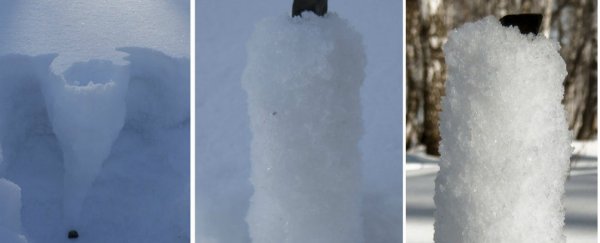You probably remember when the Chelyabinsk meteor blazed through the Russian sky back in February 2013.
When it exploded, the shockwave shook buildings, shattered windows, and injured around 1,500 people. It also sent hundreds of meteor fragments crashing into the snow-covered Earth below. But these falling rocks didn't form impact craters. Instead, they wound up at the bottom of funnel-like structures with walls of coarse, densely packed snow.
When geologists from the Russian Academy of Sciences arrived three days after the event to search for rock fragments, many of them had to use cross-country skis to scour the landscape, which was covered in more than 60 cm (24 inches) of snow.
They ultimately found about 450 samples, with an average size between 3 and 6 cm. And they weren't that hard to locate, because dark rocks were buried inside strange, conical structures, about 25 cm-long, which the geologists nicknamed "snow carrots".
 The snow carrot on the left is as it was found. The one on the right has been inverted. Credit: Cyril Lorenz (left) and Svetlana Demidova (right).
The snow carrot on the left is as it was found. The one on the right has been inverted. Credit: Cyril Lorenz (left) and Svetlana Demidova (right).
Puzzled by these structures, the geologists decided one of two things must have happened. Either the original fluffy snow was compacted by the force of the falling rock, or else the fragment, which might have still been hot - as described by some witnesses - caused partial snow melting.
As Mika McKinnon from io9 explains, in this latter hypothesis, "either the meltwater recrystallised at a higher temperature, forming coarser snow, or the water vapour along the channel walls could have condensed into coarse snow or sublimated into hoarfrost."
In a paper presented at the 46th Lunar and Planetary Science Conference in Texas earlier this month, a team of international researchers tried to simulate the conditions that would have led to the formation of these snow carrots.
They began by modelling fragments that would have had initial masses of 40 grams and 10 kilograms, respectively. They found that after the "catastrophic disruption" of the main meteorite, these fragments would have lost about 90 percent of their mass due to ablation in the atmosphere. They also would have slowed and cooled down significantly before hitting Earth.
A 40-gram fragment would have only been 1.3 cm wide when it impacted, and would have been travelling at around 28 metres/s, they report. A 10-kg fragment, meanwhile, would have eroded to the size of a tennis ball and impacted at 74 metres/s.
But for virtually every scenario modelled - save for one that looked at a large fragment of molten rock and metal - the falling fragments would have cooled to the ambient temperature of the lower atmosphere, about minus 20 degrees Celsius, by the time of impact.
This means they wouldn't have been hot enough to melt the snow, basically ruling out the second hypothesis.
"The projectile encounters the snow, pushes material out of its way forming a funnel-shaped crater. The fluffy and highly porous snow is compressed as a consequence of the penetration of the projectile into the snow," they write.
The researchers say the density of the snow adjacent to the fragment, and beneath it, increased by upwards of 18 percent, and that the impact force was great enough to form the snow carrot's 3.4-cm-thick walls.
And while their work seems to rule out the formation of the cones due to heat, they say they cannot "exclude the formation of a thin veneer of partial melt due to friction between the projectile and the snow".
While the work was largely inspired by their own curiosity, the researchers say it does have important applications for planetary science, namely understanding the forces at play during impact events in porous substances.
And as the researchers also point out, we've seen these conical structures before. During NASA's Stardust mission, comet dust came to a halt as it blasted through aerogel at 6 km/s, and formed elongated conical structures. Check out the image below.
 Comet tracks in aerogel from NASA's Stardust mission CREDIT:NASA
Comet tracks in aerogel from NASA's Stardust mission CREDIT:NASA
Source: io9
